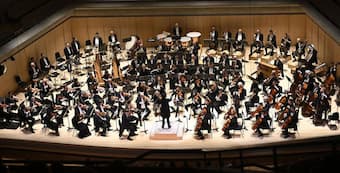
Toronto Symphony Orchestra
To land a permanent position in a symphony orchestra is a dream for many classically trained musicians. It offers job security, a good salary, medical benefits, and probably most importantly, “the opportunity to play regularly with other outstanding musicians.
Orchestra musicians are classically trained musicians, and they can usually secure a position in a symphony orchestra via an audition process. That process can follow a number of systems, but the most popular audition process today involves the submission of an audition recording. It’s not an ideal situation, as many players don’t feel they can make a good recording, or they should be invited on the basis of their reputation or having studied with a famous teacher. There are still plenty of opportunities for orchestral musicians around the world, however, and players audition for instrumental subgroups, called sections. A principal player, called the section leader or first chair, leads each section. The section leader is responsible for playing orchestral solos, signaling entrances and “determines technical details like bowing or breathing.” Many legendary players have started their careers as orchestra musicians, and although they might eventually have pursued solo or teaching careers, many committed themselves initially to orchestral music. In today’s blog, let’s have a closer look at some famous orchestra musicians.
Clarinettist: Sabine Meyer
Mozart: Clarinet Quintet (Sabine Meyer/Armida Quartet)

Sabine Meyer
Today, Sabine Meyer is one of the world’s most renowned instrumental soloists. She has appeared as a soloist with more than three hundred orchestras internationally, and she is in great demand with chamber ensembles worldwide. Meyer was a child prodigy who started playing the clarinet at an early age, being taught by her father. Meyer began her career as an orchestra musician with the Bavarian Radio Symphony Orchestra. She soon attracted the attention of Germany’s most famous orchestra, and music director Herbert von Karajan asked her to join the Berlin Philharmonic in 1982. Incredibly, she was only the second female player to join that prestigious orchestra at that time. However, the honeymoon did not last very long. Following her probationary period with the orchestra, her fellow orchestra musicians voted 73 to 4 that she should leave, suggesting, “that her sound didn’t blend in with the section.” Music director Herbert von Karajan and other observers strongly suspected the reason was her gender, and they fought for her to stay. Meyer stayed for nine months but eventually left in 1983 to pursue a highly successful career as a soloist and chamber player. She has made numerous recordings at EMI Classics, alongside recordings for Deutsche Grammophon, for Sony and for Avi-music. The recorded repertoire ranges from pre-classical to contemporary compositions and includes all the important works for clarinet. Her incredible musicianship and fight with the Berlin Philharmonic made her one of the most famous orchestra musicians of all time.
Violinist: Josef Gingold
Chopin: Mazurka (Josef Gingold)
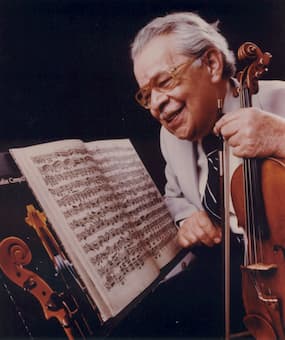
Josef Gingold
The legendary Russian-born violinist Josef Gingold immigrated to the United States with his family in 1920. He took lessons with Vladimir Graffman, and gave his New York debut at Aeolian Hall in 1926. At the age of 18, Gingold went to Brussels to study with Ysaÿe. Gingold remembered, “’Ysaÿe always had his violin in his hand and was able to play everything. He could accompany anything on his instrument in such a manner that one felt he had a full orchestra supporting him. He also had a fantastic memory and never used his music for anything. I never recall him playing a wrong harmony in any of his accompaniments. Once I remember when he was playing the Adagio from the Bach E major Concerto it was like being accompanied on an organ, so heavenly was the sound emanating from his del Gesù… His influence has remained with me all my life, his beautiful conception of music, and his belief in the long line, as far as phrasing was concerned. He believed in beauty of sound. Never was the violin treated brutally. He believed in clarity.”
Gingold gave the premiere of Ysaÿe’s Third Sonata for unaccompanied violin, and he was well on his way of becoming a celebrated soloist. However, he elected to become a teacher, educator and went on to become one of the most famous orchestra musicians of all time. He was concertmaster in Toscanini’s NBC Symphony Orchestra between 1937 and 1943, concertmaster of the Detroit Orchestra between 1943 and 1946, and he capped his orchestral career by serving for 13 years as concertmaster of the Cleveland Orchestra during the glory days of music director George Szell. He formed a close relationship with Szell, of whom he later said, “He had the greatest influence on me as a musician and, without my realizing it at the time, as a teacher.”
Flutist: James Galway
Morlacchi: Il Pastore Svizzero (James Galway)

James Galway
James Galway, the Northern Ireland son of a Belfast dockworker eventually became known as the “Man with the Golden Flute.” He first studied at the RCM with John Francis and at the GSM under Geoffrey Gilbert. On scholarship, he enrolled at the Paris Conservatoire and continued his lessons with Gaston Crunella, Jean-Pierre Rampal, and privately with Marcel Moyse. Galway got his first job in an opera company, playing second flute to William Bennett in the orchestra of Sadler’s Wells Opera. In time, Galway became principal flute and kept that position for six years. His next appointment was with the Covent Garden Opera Orchestra, “a better job, better money, and no touring.” However, he didn’t get on with the orchestral manager and returned to Sadler’s Wells after one season. Galway subsequently was a piccolo player in the BBC Symphony Orchestra, and was eventually offered a job in the London Symphony Orchestra. Galway recalled that “he couldn’t stand the bickering and backbiting in the LSO, so when the Royal Philharmonic Orchestra offered him a job at a huge salary, he took it.” He stayed with the RPO for two years, but then the principal flute position at the Berlin Philharmonic had become vacant.
Galway always loved to tell the story that “he arrived a few minutes late for his audition, which was held at a museum in Munich, and was told not to bother by the orchestra’s manager, who told him that they had heard many great players and the position was settled. Galway insisted on being heard, and eventually persuaded the manager to give him a chance. He was brought before the entire orchestra and played a Mozart concerto (after the pianist had refused to accompany him in the Ibert concerto). When he had finished, he thought, “It’s not so bad, or they would have thrown me out ages ago.” Then, a voice from the crowd (probably that of the music director Herbert von Karajan) called out, “Play William Tell.” He did, from memory. Then, “Play L’Après-midi,” then more orchestral excerpts. Whatever he was asked, he played, from memory. When this was over, there was a break, during which he met the other candidates. After a time, they were all called onto the stage, where one after the other they had to play orchestral excerpts on demand… After a time the manager reappeared and said, “Ah, Mr. Galway, you are now the solo flute of the Berlin Philharmonic. Congratulations. When can you start?” He got a startling answer: ‘Well, listen, I don’t think I want to start, because since I got here nobody has said welcome or please or thank you. Now, do you think I want to play in an orchestra with people like that?” Eventually, Galway was persuaded to try it for a month, and he remembers it as “the most amazing experience of my life. I couldn’t believe an orchestra could play like this.” Galway stayed in Berlin for six years, before shocking everyone by deciding to close his career as an orchestra musician and start on a solo career at age 35.
Horn Player: Barry Tuckwell
Richard Strauss: Horn Concerto No. 1 in E-Flat Major, Op. 11, TrV 117 (Barry Tuckwell, horn; Royal Philharmonic Orchestra; Vladimir Ashkenazy, cond.)

Barry Tuckwell
Barry Tuckwell was widely acclaimed as the preeminent horn player of his generation. He dazzled audiences with his infectious and humorous stage persona and impeccably technical quality of his playing. Absolutely flawless, Tuckwell was capable of playing the most forceful and sparkling fanfares and simultaneously he could produce silken musical lines of sublime delicacy. Asked about his mastery of his instrument Tuckwell once said in an interview, “You put air in there, and God knows what happens to it on the way. With a bit of luck, the air reaches the other end of the instrument as music.” He compared playing the horn to “driving a Mercedes at top speed on a slick road, with even the slightest mistake having disastrous consequences.” He started music lessons on the piano, the violin, and the organ, but picked up his French horn at the age of 13. Within a couple of years, Tuckwell was appointed by Joseph Post as third horn in the Melbourne Symphony Orchestra.
A year later, he joined the Sydney Symphony Orchestra under Eugene Goossens, where he remained for three and a half years before leaving for England in 1950. His first appointment was with the Hallé Orchestra under John Barbirolli in Manchester, and he subsequently spent two years with the Scottish National Orchestra under Karl Rankl. He also played with the Bournemouth Symphony Orchestra under Charles Groves, and at the age of 24 he became principle horn with the London Symphony Orchestra. During his 13 years with the LSO, a co-operative orchestra run by the players, he was elected to the board of directors and was chairman of the board for six years. The chief conductors during this time were Josef Krips, Pierre Monteux, István Kertész and André Previn. For a number of years Tuckwell acted as the director and chairman of the LSO, but administrative squabbles hastened his departure from the orchestra in 1968. Ready to pursue a solo career, he founded the Barry Tuckwell Wind Quintet and he was already highly sought after as a soloist. One of the most famous orchestra musicians of all time, Tuckwell subsequently pursued conducting opportunities with leading orchestras in Europe and the United States, and he was Chief Conductor of the Tasmanian Symphony Orchestra for four seasons.
Harpist: Emmanuel Ceysson
Ravel: Introduction and Allegro (Emmanuel Ceysson/Members of the Met Orchestra)
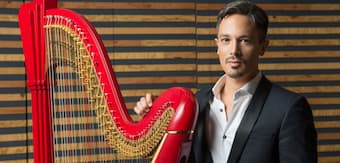
Emmanuel Ceysson
Emmanuel Ceysson can tell you everything you ever wanted to know about the audition process. He was chosen among 70 of his best colleagues in a totally blind and anonymous audition process as the new Los Angeles Philharmonic Harpist under the baton of Gustavo Dudamel in 2020. Born and raised in France, Ceysson was admitted to the Paris Conservatoire at the age of 16, and subsequently won the highest international distinctions and prizes as the Gold Medalist at the 2004 USA international Harp Competition, First Prize at the New York Young Concert Artists Auditions in 2006, and First Prize at the 2009 ARD Competition in Munich. He secured an acclaimed solo career, with a critic writing, “With his powerful, virtuoso playing, Ceysson sweeps away all the clichés associated with his instrument. His infectious enthusiasm and boundless energy reveals the harp in its entire sparkling splendor, in a word where poetry rhymes with temperament.” Brilliantly gifted as a soloist, Ceysson is also one of the most famous orchestral musicians. For almost 15 years, and before coming to Los Angeles, the “Harp Throb” as he is famously called, played in the opera pit at the Opéra National de Paris, and then for five full seasons with the legendary New York MET Opera orchestra.
Percussionist: Evelyn Glennie
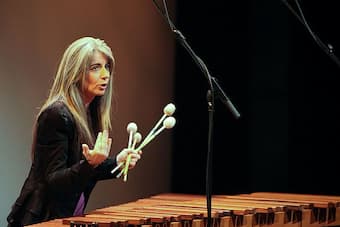
Evelyn Glennie
The Scottish percussionist Evelyn Glennie has been profoundly deaf since the age of 12. She started to lose her hearing at the age of 8 and contends, “Deafness is largely misunderstood by the public, and if the audience is only wondering how a deaf musician can play percussion, then I have failed as a musician. For this reason my deafness is not mentioned in any of the information supplied by my office to the press or concert promoters. Unfortunately, my deafness makes good headlines.” Glennie regularly plays barefoot during live performances and studio recordings to feel the music, as she has taught herself to hear with parts of her body other than her ears. As she wrote in a fascinating essay, “my hearing is something that bothers other people far more than it bothers me. There are a couple of inconveniences but in general it doesn’t affect my life much. For me, my deafness is no more important than the fact I am female with brown eyes. Sure, I sometimes have to find solutions to problems regarding my hearing and its relation to music, but so do all musicians… I became upset with a reporter for constantly asking questions only about my deafness. I said ‘if you want to know about deafness, you should interview an audiologist. My specialty is music.” Glennie was always an orchestral and ensemble musician, as she performed with the National Youth Orchestra of Scotland, and the Cults Percussion Ensemble, which she founded in 1976. She has collaborated with countless artists from all corners of the musical world, and in 2020 she worked with the music charity “Sound Word,” composing a new piece for the Coronavius Fund for Freelance Musicians. Evelyn Glennie is one of my heroes, and she is one of the most famous orchestral musicians of all time, proudly stating “Please enjoy the music and forget the rest.
For more of the best in classical music, sign up to our E-Newsletter
Vivaldi: Concerto in C major RV 443 (Evelyn Glennie)

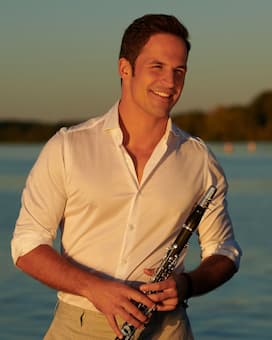
Excellent article. Thank you. How about an article on South Africa. I grew up there but now live in The Netherlands. There were and are some fantastic Musicians; Composers and Orchestras and Institutes of learning Music. I was Flute / Piccolo and Keyboard skills Lecturer for 38years at The School of Music, NWU, Potchefstroom. I was also very lucky to Premiere several new SA Flute works( all on my YouTube profile). Composers like Peter Klatzow, Hendrik Hofmeyr, Martin Watt, Hannes Taljaard, Jaco Meyer, Mathijs van Dijk, Cornelis Jordaan, Keith Moss, Clare Loveday have composed some incredible Music.
Very innovative topics, presented in a convincing way